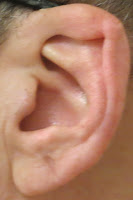I was in the mood to make something large, using tools and materials that were unfamiliar to me. Styrofoam seem like a good choice. Other students had enjoyed working with it, and there were plenty of styrofoam laying about the Sculpture Annex. I chose to create a representational form that would be instantly recognizable. However, the twist would be to present the piece in a way that the viewers would have to puzzle over it just a little.
Seven pieces of Styrofoam board left over from another student's project (partially covered with paint), were cut to size and then bonded together in three layers. Using an electric Saws-All, and then a small hand saw, the basic shape was roughed out. After that, the process of shaping the contours of the object was done using a rotary tool driven by compressed air. It had a variety of interchangeable cutting heads that went thru the Styrofoam like a hot knife through butter. I had to exercise caution so as not to remove too much material.
The finished piece had the appearance of bone, limestone, or something fossilized. This was in large part do to the "happy accident" of not having evenly mixed each batch of the wood powder and plaster. There was a lack of consistent coloration and tone which then gave the piece an organic look. It definitely had a "natural history" feel about it, which influenced the title choice of, "Artifact".
The finished piece was about 4 ft. wide x 3 ft. tall x 18" deep. and probably weighed less than twenty pounds, but it looks much heavier. I had originally planned to present it by leaning it against a wall, but decided it would look better on a stand. This would allow viewers to walk all around it, and get it up off the floor without necessarily using a pedestal.
The stand was designed on the fly. A quick sketch, and then a run to Home Depot for some lumber. I was advised to build the stand in a low key fashion or it could prove to be a distraction. Unless the stand itself is an integral part of the piece, people should not even notice it. One of my professors said, "If people are noticing and discussing the stand; then you know they don't like the piece and can't think of anything good to say about it". In other words: A fail. I painted the stand a dark gray color that exactly matched the color of the floors in the Sculpture Annex. This turned out to be a good move and really helped it remain unnoticed.
 This piece is a representation of my slightly wonky, left ear. My ear has a low grade birth defect that in no way effects my hearing (But, there have been women in my life who would argue otherwise!). When I was quite young, other kids would tease me about it, so I grew my hair long to cover it up. Later on in adult life, my girlfriends and wives adored it and gave it overly cute nick-names -- which I will not repeat here. I prefer to call it my "squinchy" ear, and leave it at that. You have to admit it is an interesting shape, and presenting my sculpture rotated 90 degrees had the desired effect of creating a bit of mystery. During the final critique, my classmates enthusiastically debated what this "bio-morphic" shape could actually be. I stood back with my professor (who was the only one who knew for sure what I had made), and allowed everyone a closer look. "Is it a whale bone?", "A fossil?", "Petrified wood?", "A dumpling?" The one that made me and my professor laugh the hardest was when someone proclaimed, "It can't be an ear. Ears don't look like that!"
This piece is a representation of my slightly wonky, left ear. My ear has a low grade birth defect that in no way effects my hearing (But, there have been women in my life who would argue otherwise!). When I was quite young, other kids would tease me about it, so I grew my hair long to cover it up. Later on in adult life, my girlfriends and wives adored it and gave it overly cute nick-names -- which I will not repeat here. I prefer to call it my "squinchy" ear, and leave it at that. You have to admit it is an interesting shape, and presenting my sculpture rotated 90 degrees had the desired effect of creating a bit of mystery. During the final critique, my classmates enthusiastically debated what this "bio-morphic" shape could actually be. I stood back with my professor (who was the only one who knew for sure what I had made), and allowed everyone a closer look. "Is it a whale bone?", "A fossil?", "Petrified wood?", "A dumpling?" The one that made me and my professor laugh the hardest was when someone proclaimed, "It can't be an ear. Ears don't look like that!" This piece was chosen by me and my professors to go into the Annual Junior/Senior Art show held each spring at the Blaffer Museum of Art.
Amazing how my squinchy left ear went from being a source of ridicule, to a unique identifier, to a praise worthy art object. Life is good.






